
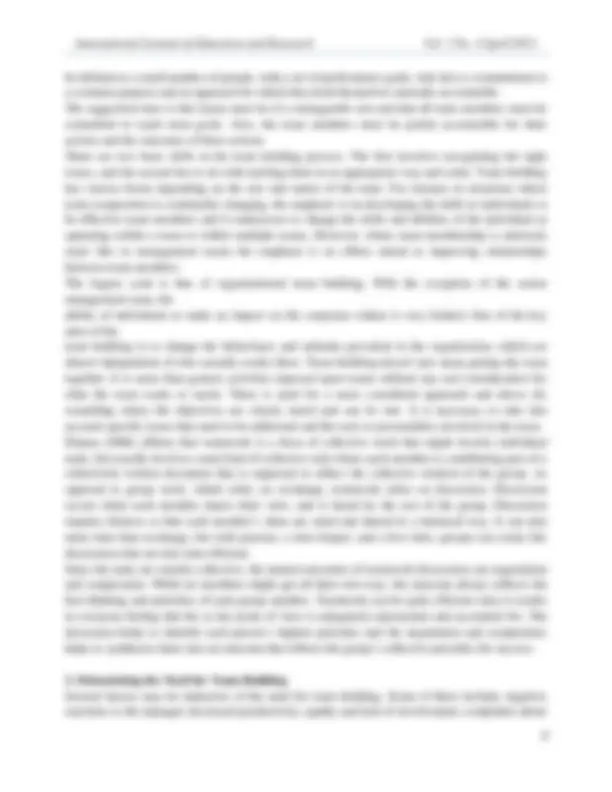
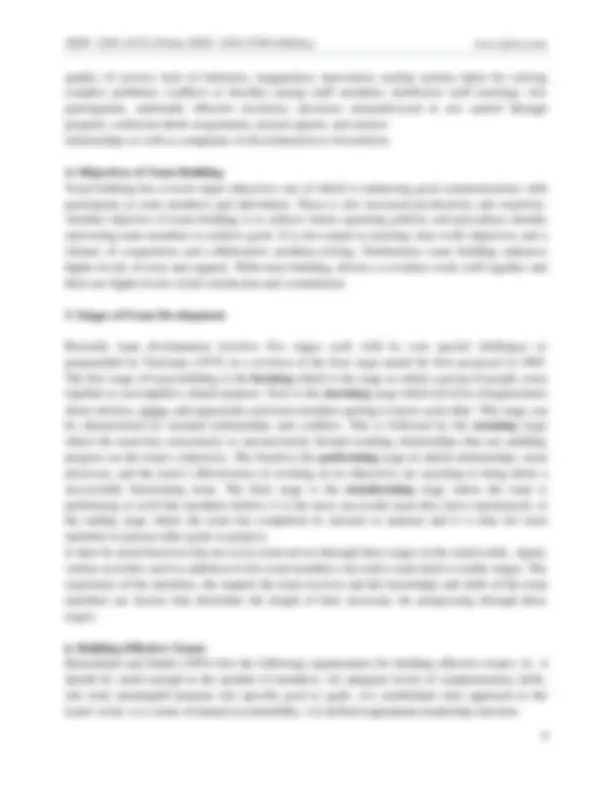
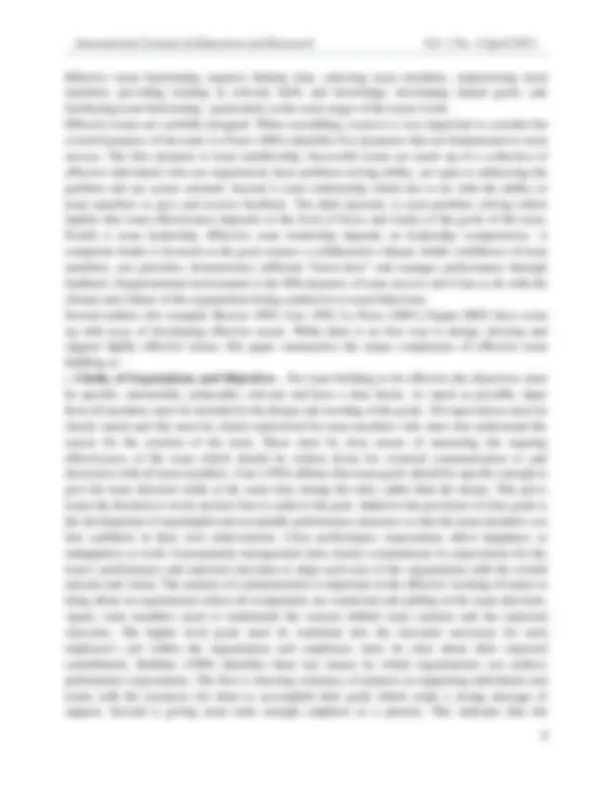
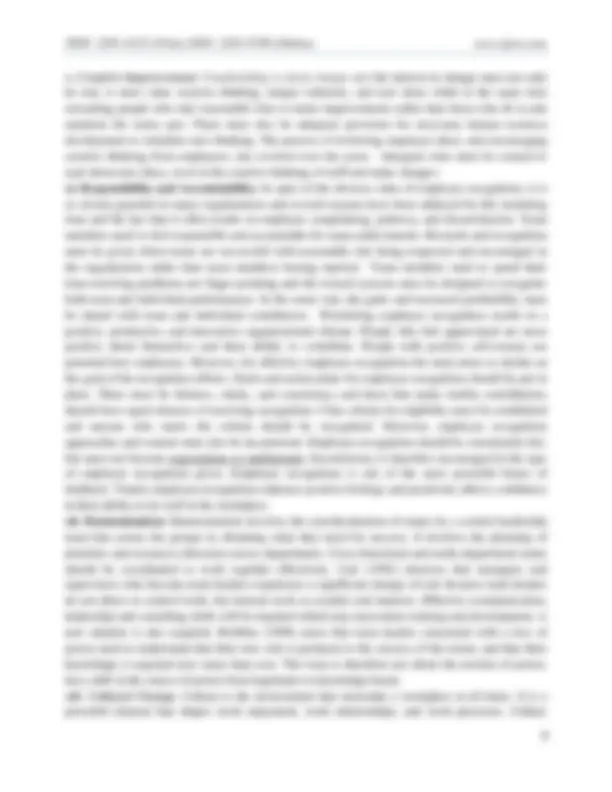
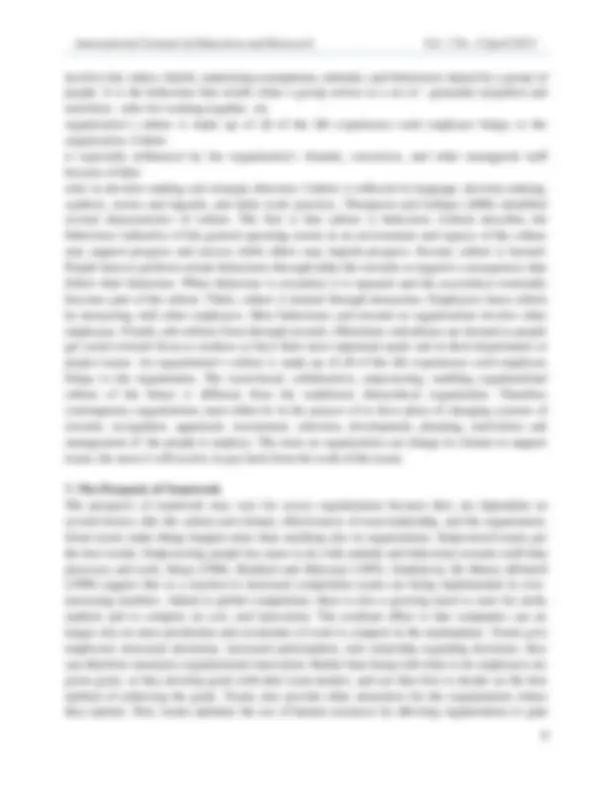
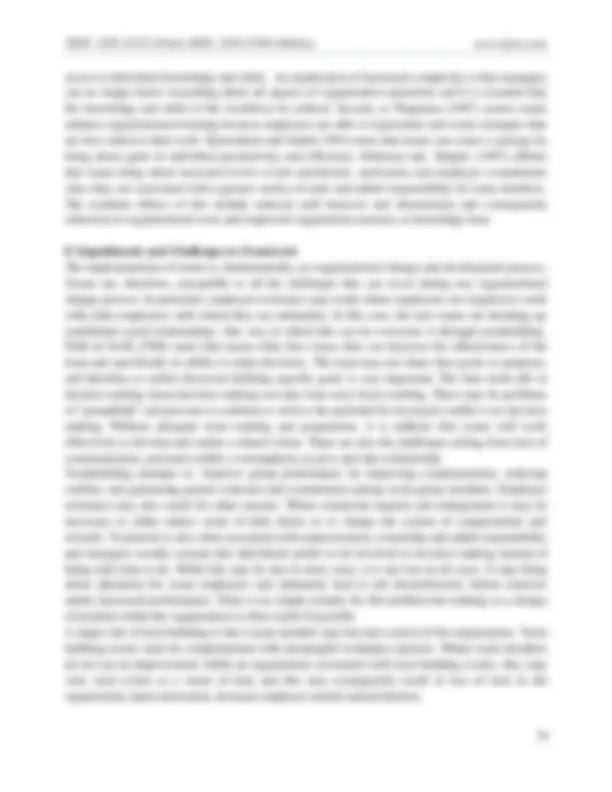


Study with the several resources on Docsity

Earn points by helping other students or get them with a premium plan


Prepare for your exams
Study with the several resources on Docsity

Earn points to download
Earn points by helping other students or get them with a premium plan
Community
Ask the community for help and clear up your study doubts
Discover the best universities in your country according to Docsity users
Free resources
Download our free guides on studying techniques, anxiety management strategies, and thesis advice from Docsity tutors
Effective team building and sales satisfaction
Typology: Study Guides, Projects, Research
1 / 12

This page cannot be seen from the preview
Don't miss anything!







International Journal of Education and Research Vol. 1 No. 4 April 2013
Fapohunda , Tinuke. M. Department of Industrial Relations and Public Administration Lagos State University Ojo. Nigeria E mail: tkfapp@gmail.com Abstract Team building involves a wide range of activities, designed for improving team performance. Its aim is to bring out the best in a team to ensure self development, positive communication, leadership skills and the ability to work closely together as a team to problem solve. This article reviews current literature on teams in an attempt to outline some of the attractions and challenges of implementing teams so as to give a realistic preview of what can be achieved through teamwork. The literature indicates that the effects of teamwork (both positive and negative) are contingent upon many factors, including the organizations’ culture and climate, effectiveness of team leadership, employee commitment, the system of compensation and rewards, and the level of employee autonomy. This article outlines eight key points that have been identified by a number of authors which facilitate the effective development of teams. These points are: clear goals; decision making authority; accountability and responsibility; effective leadership; training and development; provision of resources; organizational support; and rewards for team success. Keywords: Effective, Team, Building, Workplace
1. Introduction Team building is an important topic in the current business climate as organizations are looking to team-based structures to stimulate further improvements to their productivity, profitability and service quality. Managers and organization members universally explore ways to improve business results and profitability. Many view team-based, horizontal, structures as the best design for involving all employees in creating business success. Team-based improvement efforts strives to improve results for customers. Team building involves a wide variety of activities, presented to organizations and aimed at improving team performance. It is a philosophy of job design that sees employees as members of interdependent teams rather than as individual workers. Team building is an important factor in any environment, its focus is to specialize in bringing out the best in a team to ensure self development, positive communication, leadership skills and the ability to work closely together as a team to solve problems. While work environments often target individuals and personal goals, with reward and recognition singling out the achievements of individual employees, with good team-building skills, employees can be united around a common goal to generate greater
ISSN: 2201-6333 (Print) ISSN: 2201-6740 (Online) www.ijern.com productivity. In the absence of teams, employees are limited to individual efforts alone but with teambuilding, workgroups evolve into cohesive units and share expectations for accomplishing group tasks, added to trust and support for one another and respect for individual differences. From the early 1980s team-based structures have been replacing the highly formalized, centralized and departmentalized mechanistic structures that were previously the norm in work organizations. The use of teams has spread rapidly arising from the belief that the development of strong and effective production and managerial teams will lead to the potential for higher performance and increased job satisfaction. There are synergies to be gained from greater levels of involvement in the workforce. The team builder leads the team towards cohesiveness and productivity. A team takes on a life of its own and has to be regularly nurtured and maintained like individual employees. In a team-oriented environment, individuals contribute to the overall success of the organization. They work with other members of the organization to produce these results. While they have specific job functions and belong to specific departments, they are unified with other members to accomplish the overall objectives. The bigger picture drives their actions; and their functions exist to serve the bigger picture. Teamwork is fostered by respecting, encouraging, enthusing and caring for people, rather than exploiting or dictating to them. Heap (1996) affirms that the crux of the team building approach is love and spirituality which results in mutual respect, compassion, and humanity to work. People working for each other in teams are a more powerful force than skills, processes, and policies, annual appraisals, management-by-objectives etc. Teams usually become great teams when they decide to do it for themselves. Fostering teamwork involves creating a work culture that values collaboration; where people understand and believe that thinking, planning, decisions and actions are better when done cooperatively. Creating a culture of teamwork is dependent on management communicating clearly the expectation that teamwork and collaboration are expected; modelling teamwork in their interaction with each other and the rest of the organization; members talking about and identifying the value of a teamwork culture; rewarding and recognizing teamwork; people discussions within the company emphasizing teamwork and the performance management system emphasizing and valuing teamwork. The paper examines the development of teams in organizations. It explores key issues associated with the implementation of teamwork and examines the prospects and challenges of team building to present a realistic idea of what can be achieved through teamwork.
2. The Team Building Concept A team is a group of people working towards a common goal. Team Building involves the process of enabling the group of people to reach their goals. It consists of steps like clarification of team goals; identification of hindrances to goal achievements; facing the identified challenges and enabling the achievement of the goals. Fajana (2002) asserts that teamwork is an integration of resources and inputs working in harmony to achieve organisational goals, where roles are prescribed for every organisation member, challenges are equally faced and incremental
ISSN: 2201-6333 (Print) ISSN: 2201-6740 (Online) www.ijern.com quality of service; lack of initiation, imagination, innovation; routine actions taken for solving complex problems; conflicts or hostility among staff members; ineffective staff meetings, low participation, minimally effective decisions; decisions misunderstood or not carried through properly; confusion about assignments, missed signals, and unclear relationships as well as complaints of discrimination or favouritism.
4. Objectives of Team Building Team building has several major objectives one of which is enhancing good communications with participants as team members and individuals. There is also increased productivity and creativity. Another objective of team building is to achieve better operating policies and procedures thereby motivating team members to achieve goals. It is also aimed at ensuring clear work objectives and a climate of cooperation and collaborative problem-solving. Furthermore team building enhances higher levels of trust and support. With team building, diverse co-workers work well together and there are higher levels of job satisfaction and commitment. 5. Stages of Team Development Basically team development involves five stages each with its own special challenges as propounded by Tuckman (1975) in a revision of the four stage model he first proposed in 1965. The first stage of team building is the forming which is the stage at which a group of people come together to accomplish a shared purpose. Next is the storming stage which involves disagreements about mission, vision, and approaches and team members getting to know each other. This stage can be characterized by strained relationships and conflicts. This is followed by the norming stage where the team has consciously or unconsciously formed working relationships that are enabling progress on the team’s objectives. The fourth is the performing stage in which relationships, team processes, and the team’s effectiveness in working on its objectives are synching to bring about a successfully functioning team. The final stage is the transforming stage where the team is performing so well that members believe it is the most successful team they have experienced; or the ending stage where the team has completed its mission or purpose and it is time for team members to pursue other goals or projects. It must be noted however that not every team moves through these stages in the stated order. Again, various activities such as addition of new team members can send a team back to earlier stages. The experience of the members, the support the team receives and the knowledge and skills of the team members are factors that determine the length of time necessary for progressing through these stages. 6. Building Effective Teams Katzenbach and Smith (1993) lists the following requirements for building effective teams: (i) it should be small enough in the number of members. (ii) adequate levels of complementary skills. (iii) truly meaningful purpose (iii) specific goal or goals. (iv) established clear approach to the team's work. (v) a sense of mutual accountability. (vi) defined appropriate leadership structure.
International Journal of Education and Research Vol. 1 No. 4 April 2013 Effective team functioning requires finding time, selecting team members, empowering team members, providing training in relevant skills and knowledge, developing shared goals, and facilitating team functioning - particularly in the early stages of the team's work. Effective teams are carefully designed. When assembling a team it is very important to consider the overall dynamics of the team. La Fasto (2001) identifies five dynamics that are fundamental to team success. The first dynamic is team membership. Successful teams are made up of a collection of effective individuals who are experienced, have problem solving ability, are open to addressing the problem and are action oriented. Second is team relationship which has to do with the ability of team members to give and receive feedback. The third dynamic is team problem solving which implies that team effectiveness depends on the level of focus and clarity of the goals of the team. Fourth is team leadership. Effective team leadership depends on leadership competencies. A competent leader is focused on the goal, ensures a collaborative climate, builds confidence of team members, sets priorities, demonstrates sufficient “know-how” and manages performance through feedback. Organizational environment is the fifth dynamic of team success and it has to do with the climate and culture of the organization being conductive to team behaviour. Several authors (for example, Brower 1995; Carr 1992; La Fasto (2001); Fajana 2002) have come up with ways of developing effective teams. While there is no best way to design, develop and support highly effective teams, this paper summarizes the major components of effective team building as: i. Clarity of Expectations and Objectives - For team building to be effective the objectives must be specific, measurable, achievable, relevant and have a time frame. As much as possible, input from all members must be included in the design and wording of the goals. All expectations must be clearly stated and this must be clearly understood by team members who must also understand the reason for the creation of the team. There must be clear means of measuring the ongoing effectiveness of the team which should be written down for eventual communication to and discussion with all team members. Carr (1992) affirms that team goals should be specific enough to give the team direction while at the same time stating the ends, rather than the means. This gives teams the freedom to work out how best to achieve the goal. Added to the provision of clear goals is the development of meaningful and acceptable performance measures so that the team members can feel confident in their own achievements. Clear performance expectations affect happiness or unhappiness at work. Consequently management must clearly communicate its expectations for the team’s performance and expected outcomes to align each area of the organization with the overall mission and vision. The manner of communication is important in the effective working of teams to bring about an organization where all components are connected and pulling in the same direction. Again, team members need to understand the reasons behind team creation and the expected outcomes. The higher level goals must be translated into the outcomes necessary for each employee’s job within the organization and employees must be clear about their expected contributions. Robbins (1998) identifies three key means by which organizations can achieve performance expectations. The first is showing constancy of purpose in supporting individuals and teams with the resources for them to accomplish their goals which sends a strong message of support. Second is giving team tasks enough emphasis as a priority. This indicates that the
International Journal of Education and Research Vol. 1 No. 4 April 2013 effectively. Providing the resources depends on trust on the part of the organisation and responsibility on the part of the team members. Brower (1995) adds that as obtains for authority, resources should not, and cannot, be unlimited and should therefore be given to employees gradually. vii. Power : For effectiveness teams need authority to take decisions. Consequently a certain level of empowerment is necessary for them in order to carry out their work efficiently. Without this authority they would need to get approval for their ideas and these ideas may be rejected before they are either proven or not proven. For innovation to occur, teams must be allowed to experiment. Brower ( 1 995) suggests however that to avoid costly mistakes, it is appropriate to give teams this authority within certain boundaries. It may also be necessary to hand over authority on a gradual basis so team members are not overwhelmed by their newly-acquired authority. People are able to empower themselves through a clear focus and the removal of the sense of fear in what they do. Wilson (1996) asserts that the team must have enough freedom and empowerment for the ownership necessary to accomplish its obligation. However, there must also be a clear understanding of boundaries by team members. To achieve this management must create a work environment in which people are empowered, productive, contributing, and happy. Employee empowerment, accomplishment, and contributions can be reinforced through demonstrating value for people, sharing leadership vision, sharing goals and directions, trusting the intentions of people to do the right thing, make the right decision, and make choices that, while maybe not exactly what one would decide, still work. In addition, information for decision making should always be provided. Also delegation should go beyond just work to authority and opportunities should have effect. This helps employees to grow and develop new skills. Frequent feedback should be given so that people know how they are doing, and also to reward and to recognize. Rather than pinpointing problem people, problems should simply be solved. viii. Cooperation: This has to do with the team members understanding team dynamics and group processes. They must understand the stages of group development, their roles and responsibilities as team members and be able to work together effectively at the interpersonal level. Cooperation also involves the team being able to approach problem solving, process improvement, goal setting and measurement jointly. Added to which team members need to cooperate to accomplish the team contract and obligation. Group norms or rules of conduct in areas such as conflict resolution, consensus decision making and meeting management must be established by the team using an appropriate strategy to accomplish its action plan. ix. Communication: Effective team building involves clarity about the priority of team member’s tasks with an established method for the teams for feedback. Feedbacks must however be received with grace and dignity bearing in mind that people hesitate to give feedback to others out of fear of hurting them or having to deal with defensive or justifying behaviour. To obtain feedback there should be openness to feedback. Nevertheless, it should be noted that feedback is not always right. The reliability of the feedback should be determined by checking with others. There should be important business information regularly with team members communicating clearly and honestly with each other and bringing diverse opinions to the table. Necessary conflicts must also be raised and addressed.
ISSN: 2201-6333 (Print) ISSN: 2201-6740 (Online) www.ijern.com x. Creative Improvement: Teambuilding is about change and the interest in change must not only be real, it must value creative thinking, unique solutions, and new ideas while at the same time rewarding people who take reasonable risks to make improvements rather than those who fit in and maintain the status quo. There must also be adequate provision for necessary human resource development to stimulate new thinking. The process of reviewing employee ideas, and encouraging creative thinking from employees, has evolved over the years. Adequate time must be created to read about new ideas, revel in the creative thinking of staff and make changes. xi. Responsibility and Accountability: In spite of the obvious value of employee recognition, it is so closely guarded in many organizations and several reasons have been adduced for this including time and the fact that it often results in employee complaining, jealousy, and dissatisfaction. Team members need to feel responsible and accountable for team achievements. Rewards and recognition must be given when teams are successful with reasonable risk being respected and encouraged in the organization rather than team members fearing reprisal. Team members need to spend their time resolving problems not finger pointing and the reward systems must be designed to recognize both team and individual performances. In the same vein, the gains and increased profitability must be shared with team and individual contributors. Prioritizing employee recognition results in a positive, productive, and innovative organizational climate. People who feel appreciated are more positive about themselves and their ability to contribute. People with positive self-esteem are potential best employees. However, for effective employee recognition the need arises to decide on the goal of the recognition efforts. Goals and action plans for employee recognition should be put in place. There must be fairness, clarity, and consistency and those that make similar contributions should have equal chances of receiving recognition. Clear criteria for eligibility must be established and anyone who meets the criteria should be recognized. However, employee recognition approaches and content must also be inconsistent. Employee recognition should be consistently fair, but must not become expectations or entitlements. Inconsistency is therefore encouraged in the type of employee recognition given. Employee recognition is one of the most powerful forms of feedback. Timely employee recognition enhances positive feelings and positively affects confidence in their ability to do well in the workplace. xii. Harmonization: Harmonization involves the synchronization of teams by a central leadership team that assists the groups in obtaining what they need for success. It involves the planning of priorities and resources allocation across departments. Cross-functional and multi-department teams should be coordinated to work together effectively. Carr (1992) observes that managers and supervisors who become team leaders experience a significant change of role because team leaders do not direct or control work, but instead work as coaches and mentors. Effective communication, leadership and consulting skills will be required which may necessitate training and development. A new mindset is also required. Robbins (1998) notes that team leaders concerned with a loss of power need to understand that their new role is pertinent to the success of the teams, and that their knowledge is required now more than ever. The issue is therefore not about the erosion of power, but a shift in the source of power from legitimate to knowledge based. xiii. Cultural Change : Culture is the environment that surrounds a workplace at all times. It is a powerful element that shapes work enjoyment, work relationships, and work processes. Culture
ISSN: 2201-6333 (Print) ISSN: 2201-6740 (Online) www.ijern.com access to individual knowledge and skills. An implication of increased complexity is that managers can no longer know everything about all aspects of organization operations and it is essential that the knowledge and skills of the workforce be utilised. Second, as Wageman (1997) asserts teams enhance organizational learning because employees are able to experiment and create strategies that are best suited to their work. Katzenbach and Smith (1993) notes that teams can create a synergy by bring about gains in individual productivity and efficiency. Kirkman and Shapiro (1997) affirms that teams bring about increased levels of job satisfaction, motivation and employee commitment since they are associated with a greater variety of tasks and added responsibility for team members. The resultant effects of this include reduced staff turnover and absenteeism and consequently reduction in organizational costs and improved organization memory or knowledge base.
8. Impediments and Challenges to Teamwork The implementation of teams is, fundamentally, an organizational change and development process. Teams are, therefore, susceptible to all the challenges that can occur during any organizational change process. In particular, employee resistance may result where employees are required to work with other employees with whom they are unfamiliar. In this case, the new teams are breaking up established social relationships. One way in which this can be overcome is through teambuilding. Field & Swift ( 1996 ) notes that teams often face issues that can decrease the effectiveness of the team and specifically its ability to make decisions. The team may not share clear goals or purposes, and therefore as earlier discussed defining specific goals is very important. The time trade-offs in decision making (team decision making can take time away from working. There may be problems of "groupthink" and pressure to conform as well as the potential for increased conflict over decision making. Without adequate team training and preparation, it is unlikely that teams will work effectively to develop and realize a shared vision. There are also the challenges arising from lack of communication; personal conflict; overemphasis on give and take relationship. Teambuilding attempts to ‘improve group performance by improving communication, reducing conflict, and generating greater cohesion and commitment among work group members. Employee resistance may also result for other reasons. Where teamwork requires job enlargement it may be necessary to either reduce some of their duties or to change the system of compensation and rewards. Teamwork is also often associated with empowerment, ownership and added responsibility and managers usually assume that individuals prefer to be involved in decision making instead of being told what to do. While this may be true in most cases, it is not true in all cases. It may bring about alienation for some employees and ultimately lead to job dissatisfaction, labour turnover and/or decreased performance. There is no simple remedy for this problem but training or a change of position within the organization is often useful if possible. A major risk of team building is that a team member may become cynical of the organization. Team building events must be complemented with meaningful workplace practice. Where team members do not see an improvement within an organization associated with team building events, they may view such events as a waste of time and this may consequently result in loss of trust in the organization, harm motivation, decrease employee morale and production.
International Journal of Education and Research Vol. 1 No. 4 April 2013 Another problem is that which occurs when the teams are not trusted enough to make major decisions and consequently the teams and the organization to which they belong, are not reaching their full potentials. Seeking permission before implementing ideas reduces timeliness and ownership. Nahavandi and Aranda (1994) assert that innovation is also reduced as teams are forced to suggest solutions that are likely to be accepted. Again, team members may believe that management is merely paying lip service to the fundamental ideas of teamwork a situation that almost certainly reduces employee morale. Inability to trust teams to make decisions results in teams taking up more time than the system they replaced. The experience is similar where coordination is required and a number of teams are interdependent. This type of challenge requires continued training and development of team members. Argote and McGrath ( 1993 ) suggests that coordination needs effective team leadership and team performance requires a balance between autonomy and decentralisation of power on the one hand, for the sake of both motivation and flexibility, and centralised control on the other hand, for the sake of coordination and predictability. As obtains with all organizational change and development initiatives, the organizational culture and climate must be considered. One cannot assume that the goals and values of employees are the same as the goals of management, or even that goals and values are consistent across the organization. Employee attitudes about teams determine the likelihood of success. Carr (1992) observes that successful team implementation involves an extension of existing values but team implementation may also be useful for desired culture change. Teamwork demands such a shift in attitudes that organizations may turn to it when they want to achieve a cultural transformation. Also important are the effects of team building as they relate to employees' families and people's broader life needs. Divisive treatment of employees' spouses and families undermine the loyalty and motivation of employees, and create additional and unnecessary stress for workers in close loving caring relationships, especially for young families, which have evolved a strong sensitivity to such pressures. Strong work commitments put pressure on employees' families and spouses and modern organizations should be doing minimizing the effects, not making them worse. Families of employees can be rewarded for their support and loyalty, rather than alienated by creating selfish staff-only events and benefits. Fostering a healthy work and home life balance tends to make organizations run smoother and less problematically, especially in areas of grievance and counseling, stress and conflict, disputes and litigation, recruitment and staff retention, succession planning, company reputation and image. There are also the implications and risks of organizing socially irresponsible team events and activities which affect performance, management distraction, and staff retention; risks of litigation and bad publicity. A socially responsible employer should be able to demonstrate they have been duly careful and diligent in minimizing such risks when organizing any work events. Finally, there are always going to be those resistant to the very idea of “team building” or others whose comfort zone is very small. This must be acknowledged and programme that takes it into account created.
9. Conclusion Implementing and supporting teams in an organization, needs considerable organizational change and consideration of many issues. The entire organization ranging from the team members,